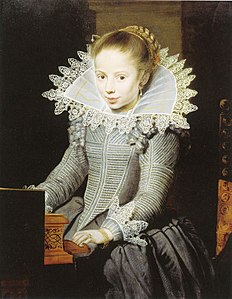
Blackwork, sometimes historically termed Spanish blackwork, is a form of embroidery generally worked in black thread, although other colours are also used on occasion, as in scarletwork, where the embroidery is worked in red thread. Originating in Tudor period England, blackwork typically, though not always, takes the form of a counted-thread embroidery, where the warp and weft yarns of a fabric are counted for the length of each stitch, producing uniform-length stitches and a precise pattern on an even-weave fabric. Blackwork may also take the form of free-stitch embroidery, where the yarns of a fabric are not counted while sewing.
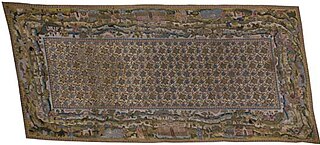
The Bradford Carpet is a canvas work embroidery made in the early 17th century that originally belonged to the Earl of Bradford at Castle Bromwich.

Lace is a delicate fabric made of yarn or thread in an open weblike pattern, made by machine or by hand. Generally, lace is divided into two main categories, needlelace and bobbin lace, although there are other types of lace, such as knitted or crocheted lace. Other laces such as these are considered as a category of their specific craft. Knitted lace, therefore, is an example of knitting. This article considers both needle lace and bobbin lace.
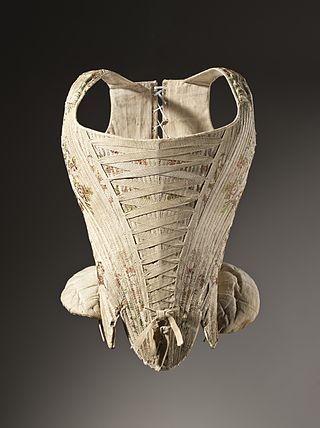
The corset has been an indispensable supportive undergarment for women, in Europe for several centuries, evolving as fashion trends have changed and being known, depending on era and geography, as a pair of bodies, stays and corsets. The appearance of the garment represented a change from people wearing clothes to fit their bodies to changing the shape of their bodies to support and fit their fashionable clothing.
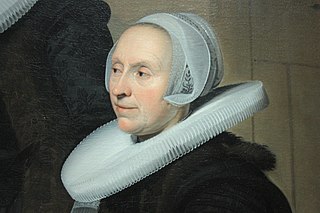
A ruff is an item of clothing worn in Western, Central, and Northern Europe and Spanish America from the mid-16th century to the mid-17th century. The round and flat variation is often called a millstone collar after its resemblance to millstones for grinding grain.

A piccadill or pickadill is a large broad collar of cut-work lace that became fashionable in the late 16th century and early 17th century. The term is also used for the stiffened supporter or supportasse used to hold such a collar in place.

In clothing, a collar is the part of a shirt, dress, coat or blouse that fastens around or frames the neck. Among clothing construction professionals, a collar is differentiated from other necklines such as revers and lapels, by being made from a separate piece of fabric, rather than a folded or cut part of the same piece of fabric used for the main body of the garment.

Fashion in the period 1550–1600 in Western European clothing was characterized by increased opulence. Contrasting fabrics, slashes, embroidery, applied trims, and other forms of surface ornamentation remained prominent. The wide silhouette, conical for women with breadth at the hips and broadly square for men with width at the shoulders had reached its peak in the 1530s, and by mid-century a tall, narrow line with a V-lined waist was back in fashion. Sleeves and women's skirts then began to widen again, with emphasis at the shoulder that would continue into the next century. The characteristic garment of the period was the ruff, which began as a modest ruffle attached to the neckband of a shirt or smock and grew into a separate garment of fine linen, trimmed with lace, cutwork or embroidery, and shaped into crisp, precise folds with starch and heated irons.

Fashion in the years 1750–1775 in European countries and the colonial Americas was characterised by greater abundance, elaboration and intricacy in clothing designs, loved by the Rococo artistic trends of the period. The French and English styles of fashion were very different from one another. French style was defined by elaborate court dress, colourful and rich in decoration, worn by such iconic fashion figures as Marie Antoinette.
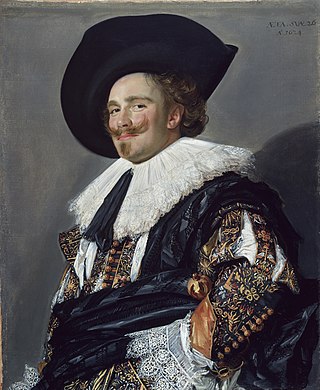
Fashion in the period 1600–1650 in Western European clothing is characterized by the disappearance of the ruff in favour of broad lace or linen collars. Waistlines rose through the period for both men and women. Other notable fashions included full, slashed sleeves and tall or broad hats with brims. For men, hose disappeared in favour of breeches.

Bands are a form of formal neckwear, worn by some clergy and lawyers, and with some forms of academic dress. They take the form of two oblong pieces of cloth, usually though not invariably white, which are tied to the neck. When worn by clergy, they typically are attached to a clerical collar. The word bands is usually plural because they require two similar parts and did not come as one piece of cloth. Those worn by clergy are often called preaching bands or Geneva bands; those worn by lawyers are called barrister's bands or, more usually in Ireland and Canada, tabs. Preaching bands symbolize the two tablets of the Ten Commandments given by God to Moses.

Fashion in the period 1500–1550 in Western Europe is marked by very thick, big and voluminous clothing worn in an abundance of layers. Contrasting fabrics, slashes, embroidery, applied trims, and other forms of surface ornamentation became prominent. The tall, narrow lines of the late Medieval period were replaced with a wide silhouette, conical for women with breadth at the hips and broadly square for men with width at the shoulders. Sleeves were a center of attention, and were puffed, slashed, cuffed, and turned back to reveal contrasting linings.

Boothose are over-stockings or boot liners worn in the sixteenth and seventeenth centuries to protect fine knitted stockings from wear. They first appear around 1450.
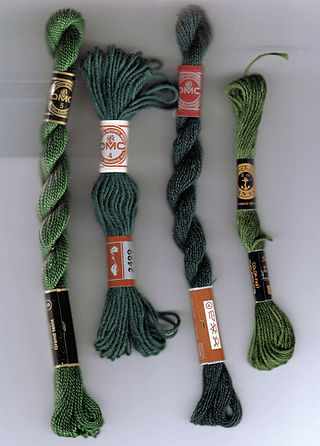
Embroidery thread is yarn that is manufactured or hand-spun specifically for embroidery and other forms of needlework. Embroidery thread often differs widely, coming in many different fiber types, colors and weights.
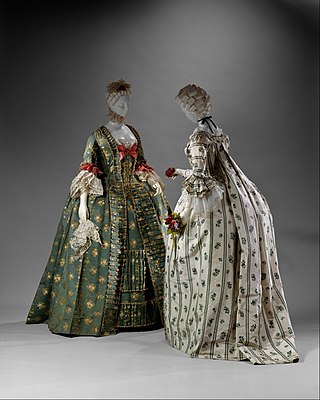
The sack-back gown or robe à la française was a women's fashion of 18th century Europe. At the beginning of the century, the sack-back gown was a very informal style of dress. At its most informal, it was unfitted both front and back and called a sacque, contouche, or robe battante. By the 1770s the sack-back gown was second only to court dress in its formality. This style of gown had fabric at the back arranged in box pleats which fell loose from the shoulder to the floor with a slight train. In front, the gown was open, showing off a decorative stomacher and petticoat. It would have been worn with a wide square hoop or panniers under the petticoat. Scalloped ruffles often trimmed elbow-length sleeves, which were worn with separate frills called engageantes.

English embroidery includes embroidery worked in England or by English people abroad from Anglo-Saxon times to the present day. The oldest surviving English embroideries include items from the early 10th century preserved in Durham Cathedral and the 11th century Bayeux Tapestry, if it was worked in England. The professional workshops of Medieval England created rich embroidery in metal thread and silk for ecclesiastical and secular uses. This style was called Opus Anglicanum or "English work", and was famous throughout Europe.

Bizarre silks are a style of figured silk fabrics popular in Europe in the late 17th and early 18th centuries. Bizarre silks are characterized by large-scale, asymmetrical patterns featuring geometrical shapes and stylized leaves and flowers, influenced by a wave of Asian textiles and decorative objects reaching the European market in these decades. Bizarre silks were used for both clothing and furnishings. As a description, the term was first used by Dr. Vilhelm Sloman in the title of a book, Bizarre Designs in Silks published in 1953 in Copenhagen.

A caraco is a style of woman's jacket that was fashionable from the mid-18th to early 19th centuries. Caracos were thigh-length and opened in front, with tight three-quarter or long sleeves. Like gowns of the period, the back of the caraco could be fitted to the waist or could hang in pleats from the shoulder in the style of a sack back. Caracos were generally made of printed linen or cotton.

Cieszyn folk costume, also known as Valachian, is a Silesian folk costume, which used to be worn within majority of the area of Cieszyn Silesia, but mostly by Cieszyn Vlachs. Taking into consideration ornamentation, cutting and materials, it can be observed that it is a replica of historical costumes of the Renaissance. The male folk costume was worn only to the late 19th century, whereas the female folk costume was more popular and spread in the vicinity of the Wisła, Istebna and Koniaków. Previously in this area the costumes of Silesian Gorals prevailed. Female folk costumes in Cieszyn were subjected to many changes, especially in respect to ornamentations and better quality of materials. Due to its richness and elegance the costume quickly became a target of artists and specialists in folk culture.

Ipswich lace is a historical fashion accessory, the only known American hand-made bobbin lace to be commercially produced. Centered in the coastal town of Ipswich, Massachusetts north of Boston, a community of lacemaking arose in the 18th century. Puritan settlers to the area likely made and wore lace as early as 1634, because Sumptuary laws from the early colonial records indicate this activity. Earliest known records of the commercial production indicate that lace produced by local women was used to barter for goods in the 1760s, as denoted by ledger account books belonging to local merchants. These laces were sold in the region from Boston to Maine.


